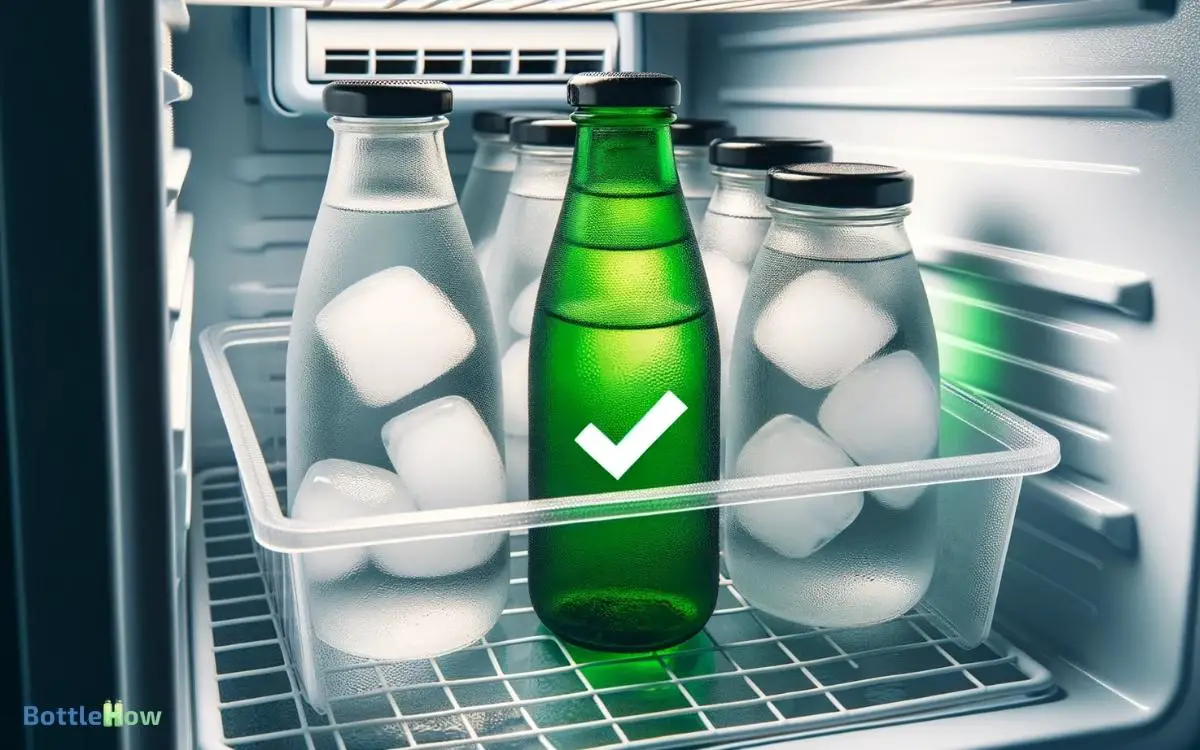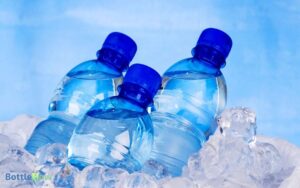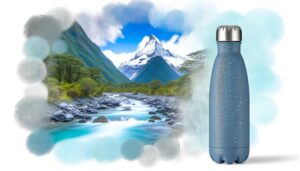Can You Put a Glass Water Bottle in the Freezer? Yes!
Putting a glass water bottle in the freezer isn’t advisable. When water freezes, it expands by about 9%, which exerts significant pressure on glass.
Glass is a brittle material and can’t handle this stress well, increasing the risk of shattering. Even tempered glass, designed to shatter into safer pieces, isn’t immune to damage from sudden temperature changes.
The expansion and contraction can cause microfractures, compromising the bottle’s integrity. Additionally, common types of glass like soda-lime have low thermal resistance, making them more prone to cracking. There are safer alternatives and best practices that can mitigate these risks.

Key Takeaways
Understanding Glass and Freezing
When you place a glass water bottle in the freezer, it undergoes thermal stress due to the rapid temperature change and the expansion of freezing water. Glass, being a brittle material, doesn’t handle sudden temperature shifts well.
The water inside the bottle freezes and expands by approximately 9%, exerting pressure on the glass walls.
This expansion is a well-documented physical property of water as it changes from liquid to solid state at 0°C.
The glass, lacking the flexibility to accommodate this increase in volume, experiences significant internal stress.
Studies show that even tempered glass, which is stronger than regular glass, isn’t immune to such stress.
Understanding these mechanics can help you make informed decisions about using glass containers in freezing conditions.
Risks of Freezing Glass Bottles
When you freeze a glass water bottle, the water expands as it turns into ice, which can compromise the bottle’s integrity.
This expansion exerts pressure on the glass, increasing the risk of shattering. Evidence shows that sudden temperature changes further exacerbate this risk, making it a potentially hazardous practice.
Expansion and Glass Integrity
Freezing a glass water bottle poses significant risks due to the expansion of water as it turns to ice, which can compromise the bottle’s structural integrity.
Water expands by approximately 9% when it freezes. This expansion exerts significant pressure on the walls of the glass bottle.
Glass, being a brittle material, has a limited ability to withstand such internal stress. When the water inside the bottle freezes, the resulting pressure can create microfractures or even cause the glass to weaken over time.
Even if the bottle doesn’t break immediately, these structural changes can make it more susceptible to damage in the future.
As a result, freezing a glass water bottle isn’t advisable due to the inherent risks associated with water expansion and glass integrity.
Potential for Shattering
As the internal pressure from expanding ice builds, it can cause the glass bottle to shatter, posing a significant safety hazard.
When water freezes, it expands by approximately 9%. This expansion creates internal stress within the glass structure.
Most glass bottles aren’t designed to accommodate such changes in pressure. Even minor imperfections in the glass can become focal points for stress, leading to breakage.
Studies have shown that temperatures below 0°C (32°F) exacerbate this risk, making shattering more likely. Additionally, the rapid temperature change from room temperature to freezing can induce thermal shock.
To prevent accidents, always consider these factors before placing a glass water bottle in the freezer. Your safety is paramount.
Thermal Expansion Explained
When you place a glass water bottle in the freezer, the water inside expands as it freezes, exerting stress on the glass.
This temperature change causes the glass to contract, but not uniformly, leading to potential fractures.
The combination of expanding ice and contracting glass creates significant material stress, increasing the risk of the bottle shattering.
Temperature Change Effects
Due to the principles of thermal expansion, placing a glass water bottle in the freezer can lead to the bottle cracking or shattering as the water inside freezes and expands.
Water expands approximately 9% when it changes from liquid to solid state. This expansion exerts significant pressure on the glass, which is a rigid material with low elasticity.
The rapid temperature change also contributes to thermal stress, causing the glass to become brittle and more susceptible to breaking.
Studies show that glass can only withstand minor fluctuations in temperature before it reaches a critical stress point.
Understanding these temperature change effects is essential to prevent damaging your glass water bottle and potentially causing a hazardous situation in your freezer.
Material Stress Factors
Thermal expansion, a critical material stress factor, frequently causes glass to crack or shatter when exposed to extreme temperature changes.
When you put a glass water bottle in the freezer, the water inside begins to freeze and expand. Glass, having a low thermal conductivity, doesn’t distribute the temperature evenly, creating internal stress. This stress can lead to fractures or complete breakage.
Studies show that glass can only withstand a limited amount of stress before failure. The coefficient of thermal expansion for glass is around 9 x 10^-6 /°C, indicating its susceptibility to temperature-induced stress.
You should recognize that even a small temperature differential can create enough internal pressure to compromise the structural integrity of the bottle.
Types of Glass Bottles
Not all glass water bottles are created equal, as they vary in material composition, durability, and thermal resistance. Understanding these differences is essential to determine if freezing is safe.
| Glass Type | Characteristics |
|---|---|
| Soda-lime glass | Common, lower thermal resistance, prone to cracking |
| Borosilicate glass | Higher thermal resistance, durable, less likely to crack under temperature changes |
| Tempered glass | Strengthened through controlled thermal processes, shatters into small, less hazardous pieces |
Safe Freezing Practices
Ensuring the safe freezing of a glass water bottle involves understanding the material’s thermal properties and following best practices to avoid breakage.
Glass expands when it freezes, and this expansion can cause the bottle to crack or shatter. Always leave at least 10-15% of the bottle empty to allow for ice expansion.
Opt for borosilicate glass, which is more resistant to thermal stress. Avoid sudden temperature changes; let the bottle cool in the refrigerator before transferring it to the freezer.
Check the manufacturer’s guidelines, as some glass bottles aren’t designed for freezing. By adhering to these practices, you can minimize the risk of breakage and safely freeze your glass water bottle.
Alternatives to Freezing
If you want to avoid the risks associated with freezing glass water bottles, consider using alternatives like insulated stainless steel bottles or BPA-free plastic containers.
Insulated stainless steel bottles maintain cold temperatures for extended periods without the risk of shattering. Research indicates that stainless steel can keep liquids cold for up to 24 hours.
BPA-free plastic containers are another viable option; they’re lightweight, durable, and designed to withstand freezing conditions. High-quality BPA-free plastic can safely endure freezing without compromising structural integrity.
Quick Cooling Tips
For rapid cooling without compromising safety, immerse your bottle in an ice-water bath, which accelerates heat transfer through direct contact.
The combination of ice and water guarantees a more efficient cooling process than ice alone, as the liquid medium facilitates better thermal conductivity.
Additionally, you can rotate the bottle periodically to maximize surface area exposure to the cold water.
Alternatively, wrap the bottle in a wet paper towel and place it in the refrigerator. The evaporative cooling effect will speed up the process.
Conclusion
You absolutely shouldn’t put a glass water bottle in the freezer. The risk of it shattering is higher than the tallest mountain, primarily due to thermal expansion. As the water inside freezes, it expands, putting immense pressure on the glass until it eventually cracks or explodes. This can leave you with a dangerous mess of shattered glass and frozen chunks of ice. If you’re thinking about storing beer in a water bottle and freezing it, the same risk applies – it’s better to use a container designed to withstand extreme temperatures.
Even though some glass types are more resistant, it’s not worth the gamble. Instead, consider safe freezing practices or quick cooling methods to avoid any mishaps.
By following these guidelines, you can guarantee your beverage is chilled without turning your freezer into a hazardous mess.





